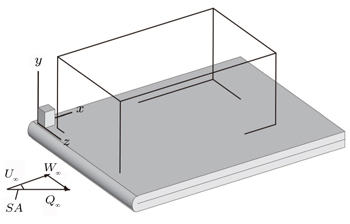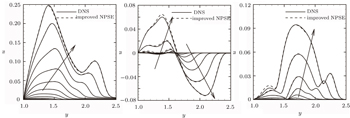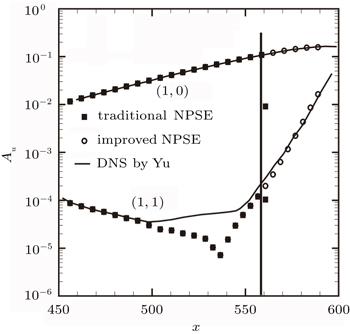† Corresponding author. E-mail:
Project supported by the National Natural Science Foundation of China (Grant Nos. 11332007 and 11402167).
Due to its high computational efficiency and ability to consider nonparallel and nonlinear effects, nonlinear parabolized stability equations (NPSE) approach has been widely used to study the stability and transition mechanisms. However, it often diverges in hypersonic boundary layers when the amplitude of disturbance reaches a certain level. In this study, an improved algorithm for solving NPSE is developed. In this algorithm, the mean flow distortion is included into the linear operator instead of into the nonlinear forcing terms in NPSE. An under-relaxation factor for computing the nonlinear terms is introduced during the iteration process to guarantee the robustness of the algorithm. Two case studies, the nonlinear development of stationary crossflow vortices and the fundamental resonance of the second mode disturbance in hypersonic boundary layers, are presented to validate the proposed algorithm for NPSE. Results from direct numerical simulation (DNS) are regarded as the baseline for comparison. Good agreement can be found between the proposed algorithm and DNS, which indicates the great potential of the proposed method on studying the crossflow and streamwise instability in hypersonic boundary layers.
The mechanisms of transition from laminar to turbulent flow are of strong academic interests. Understanding the transition process and predicting its location are necessary for accurate computing of aerodynamic drag and heat protection configurations. Under flight conditions, natural transition is dominant because of the low free stream turbulence level. Therefore, stability theory plays a significant role in understanding the transition. There are usually three methods to describe the amplification of unstable disturbances in boundary layers. They are linear stability theory (LST), direct numerical simulation (DNS), and (nonlinear) parabolized stability equations (PSE/NPSE). LST is a local method based on the quasi-parallel hypothesis. It can predict the linear growth of an infinitesimal disturbance well.[1,2] However, it ignores the nonparallel and nonlinear effects. DNS can obtain complete information of disturbances through solving the Navier–Stokes equations directly but with high computational demands. NPSE approach developed by Bertolotti and Herbert[3,4] takes into account the nonparallel and nonlinear effects, the solution accuracy of NPSE is comparable with DNS while the computational cost is much less.
NPSE is solved by a marching method. Due to its high computational efficiency and accuracy, The NPSE approach has been widely used to study the stability and transition. This approach was initially applied to an incompressible Blasius boundary layer by Bertolotti.[3,4] Then its application was extended to three-dimensional flow and compressible flow.[5] For the crossflow instability, Wang et al.[6] applied this approach to calculate the development of crossflow waves and predicted the nonlinear saturation characteristic. Haynes[7] made detailed comparisons between NPSE results and experimental measurements.[8] The remarkably good agreements validated this approach for three-dimensional flow subjected to crossflow instability. Malik[9] adopted this approach to simulate the nonlinear development of stationary crossflow vortices over a swept airfoil, and investigated the secondary instability of saturated crossflow vortices. Xu[10,11] and Li[12,13] also obtained the baseflow for the secondary instability analysis by this approach.
For investigating the transition dominated by streamwise instabilities, NPSE approach is also an efficient method. By this approach, Zhang and Zhou[14] investigated the subharmonic resonance in a subsonic boundary layer and acquired an essential agreement with DNS results.[15] Mayer[16] simulated the oblique breakdown initialized by first-mode disturbances in a Ma = 3 boundary layer by NPSE approach. The transition onset location agrees well with DNS results.[17] Zhang and Zhou[18] also investigated the subharmonic secondary instability induced by first-mode and second-mode disturbances in a Ma = 4.5 boundary layer by this approach.
Despite the computational advantage of the NPSE approach, numerical instabilities may lead to convergence failure when the disturbance amplitude increases to a threshold,[19] especially in hypersonic flow.[20] Chang[21] and Li[12] calculated the development of stationary crossflow vortices in a Ma = 2.4 supersonic flow over a swept airfoil. For the most unstable mode disturbances, all calculations diverge when the amplitudes of the disturbances reach the levels of about 0.17. Kuehl[22] also investigated the development of stationary crossflow vortices in a hypersonic boundary on a cone with 6 degree yaw. The NPSE calculation also diverges in downstream when the amplitude reaches about 0.13. The work of Kuehl concludes that the NPSE approach tends to diverge when the amplitudes of stationary crossflow disturbances increase to a certain level in hypersonic flow. However, the saturated stationary crossflow vortices are required to be considered in order to study the breakdown induced by the secondary instability as in the case of low-speed or/and subsonic flow.
For this aim, therefore, an improved algorithm for solving NPSE is developed in this research. The nonlinear development of stationary crossflow vortices and the fundamental resonance of second-mode disturbances are investigated in hypersonic boundary layers. The results obtained by the improved NPSE approach were compared with those by the traditional NPSE approach and DNS for validation.
In general, the instantaneous flow quantities

Each perturbation quantity is assumed to be periodic in temporal and spanwise directions; the disturbances and nonlinear terms are then expressed by the truncated Fourier series








By analyzing the magnitude of each term in Eq. (






Equation (




The marching approach for solving Eq. (
In hypersonic boundary layers, the traditional NPSE approach easily diverges when the nonlinear interactions are significant. Chang[19] pointed out that these significant nonlinear interactions lead the nonlinear forcing terms to carry more weight than linear operator in the NPSE. Dong[23] and Cao[24] found that the mean flow distortion has a significant contribution to the instabilities of higher harmonic modes. In their work, the mean flow distortion was added to the base flow and the stability of the distorted base flow was study. The results from their work indicate the superiority of adding the flow distortion in a linear operator rather than the nonlinear forcing terms. What is more, moving the mean flow distortion into the linear operator benefits to reduce the weight of the nonlinear forcing terms. The improved algorithm for NPSE proposed by this paper is based on this idea.
Different from the traditional approach, the improved algorithm considers the mean flow distortion in the linear operator. The iterative form governing equations of the improved algorithm can be represented as


Additionally, an under-relaxation factor is introduced in the formula (

The improved NPSE approach is applied to two challenging research cases in this study. One is the nonlinear development of stationary crossflow vortices in a hypersonic three-dimensional boundary layer; the other is the fundamental resonance of second-mode disturbances in a hypersonic flat-plate boundary layer. In order to verify the effectiveness and reliability of this improved approach, the results by traditional NPSE approach and by DNS are also provided as comparisons.
Accurately simulating the nonlinear developments and amplitude saturation characteristics of stationary crossflow vortices is a necessary work for studying the crossflow secondary instability. In hypersonic three-dimensional boundary layers, however, the traditional NPSE algorithm tends to diverge when the amplitude of disturbance amplifies to a threshold.[21,22]
Figure 
Figure
 | Fig. 2. Velocity distribution at x*/R0 = 6, 12, 18, 24, 30, 36, 42 (The arrow marks the increase of x* location): (a) Streamline velocity profiles; (b) Crossflow velocity profiles. |
Figure
The inlet conditions for NPSE and DNS are provided by the LST results. For the unstable disturbance with the spanwise wavelength 54.98 mm, the N factor (see Fig. (
Figure
For the case of A0 = 1×10−3, as shown in Fig.
For the unstable disturbance with the spanwise wavelength 109.96 mm, the LST result (see Fig.
When the initial amplitude increases to A0 = 1×10−3, as shown in Fig.
As shown in Figs.
To further examine the improved NPSE approach, the eigenfunctions development of streamwise velocity disturbance are studied. In Fig.
When the traditional NPSE approach is applied to calculate the fundamental resonance of second-mode disturbances, it usually diverges before the 3D disturbance amplifies to a large amplitude. Therefore, the computational work on this subject is mainly done by DNS rather than by NPSE approach. In this section, the improved NPSE approach is applied to study the fundamental resonance of second mode disturbances in a hypersonic boundary layer.
Yu[25] investigated the nonlinear interaction mechanisms of disturbances in supersonic flat-plate boundary layers by DNS. In Ref. [25], the case1 in the table 1 illustrated the nonlinear interaction mechanisms of Klebanoff-type second mode disturbances. The same case is investigated by the improved NPSE approach in this study. An unstable 2D disturbance of the second mode is introduced at the inlet, accompanied by a pair of stable 3D disturbances with the same frequency. Figure
An improved algorithm for solving NPSE is developed in this paper to address the divergence problem of the traditional NPSE solving technique for hypersonic flow. In this approach, the mean flow distortion generated by nonlinear interaction is included into the linear operator. An under-relaxation factor is introduced in the iterative computation of the nonlinear terms. This improved NPSE approach is applied to study the nonlinear evolution of disturbances induced by the crossflow instability and streamwise instability in hypersonic boundary layers. Good agreement with DNS is achieved in the challenging cases. The improved algorithm is able to accurately capture the large-amplitude saturation characteristic of stationary crossflow vortices and the process of fundamental resonance in hypersonic flow. It is shown that the proposed algorithm has great potential in studying the crossflow instability and streamwise instability in hypersonic boundary layers.
| 1 | |
| 2 | |
| 3 | |
| 4 | |
| 5 | |
| 6 | |
| 7 | |
| 8 | |
| 9 | |
| 10 | |
| 11 | |
| 12 | |
| 13 | |
| 14 | |
| 15 | |
| 16 | |
| 17 | |
| 18 | |
| 19 | |
| 20 | |
| 21 | |
| 22 | |
| 23 | |
| 24 | |
| 25 |








